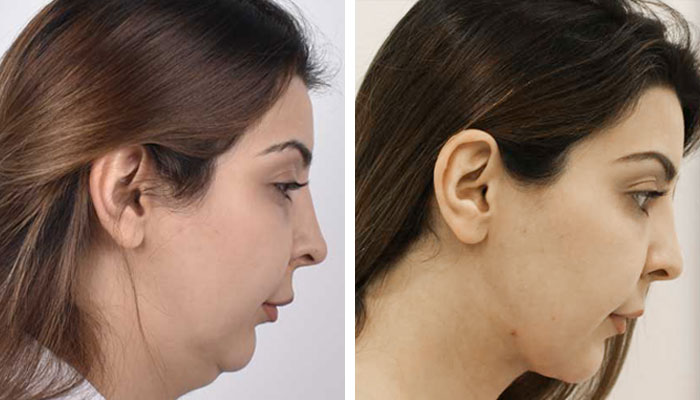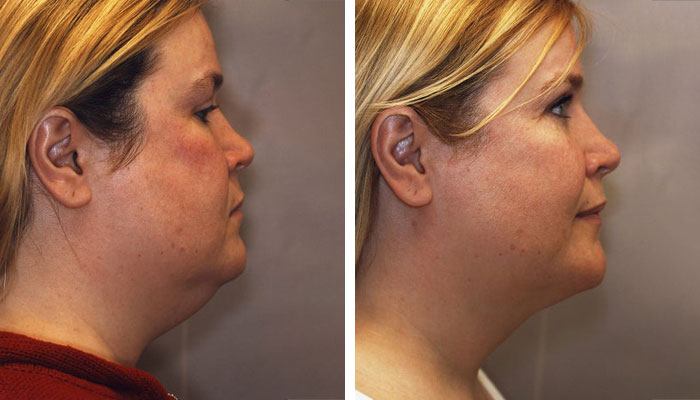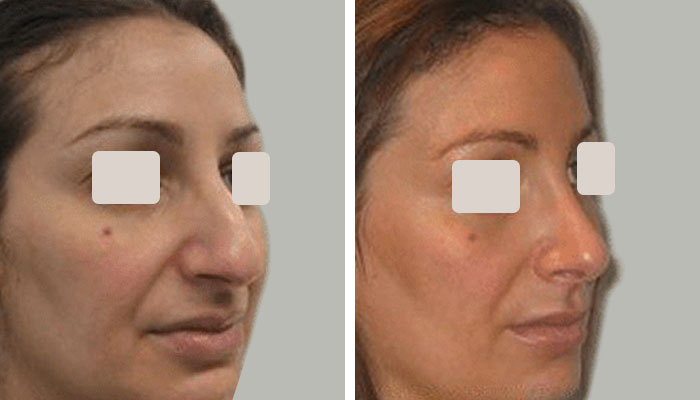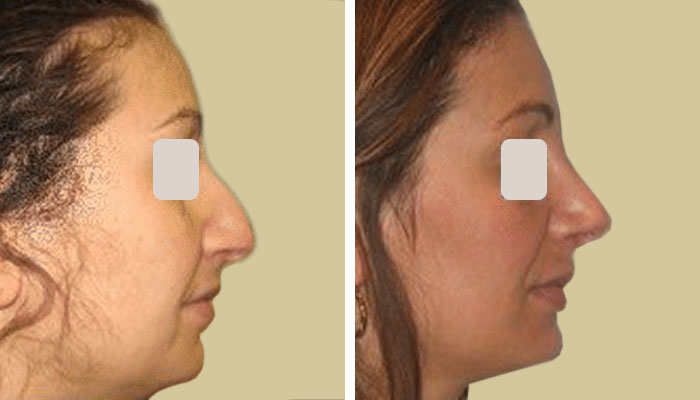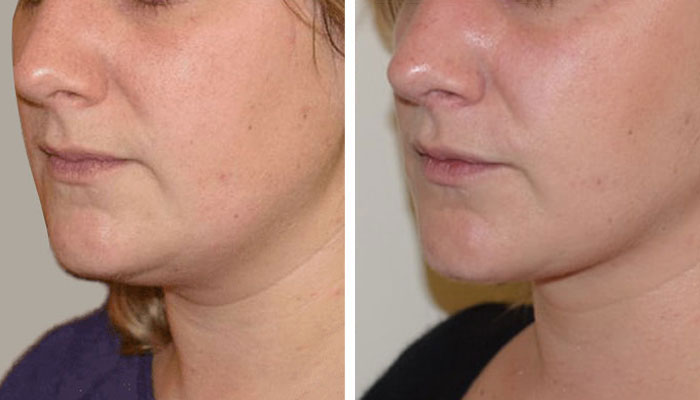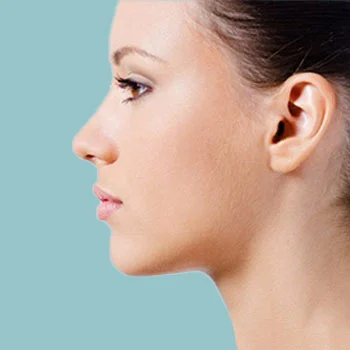What is a double chin?
Double chin, also known as submental fat or fullness, is a common condition characterized by the accumulation of excess fat or sagging skin beneath the chin, resulting in a visible fold or bulge. It is considered a cosmetic issue because it affects one's facial profile and overall appearance.
A double chin is often perceived as undesirable and can contribute to self-consciousness and dissatisfaction with one's appearance. It can affect both men and women of various ages and body types and make individuals appear overweight or older than they actually are. Many people seek treatment for a double chin to enhance their facial harmony, improve their jawline definition, and achieve a more youthful and aesthetically pleasing look.
What causes a double chin?
Several factors can contribute to the development of a double chin. These include:
- Genetics: Some individuals may have a genetic predisposition to store excess fat in the submental area, making them more prone to developing a double chin even at a healthy weight.
- Weight gain: Excess weight and obesity can lead to the accumulation of fat in various parts of the body, including the area under the chin. When a person gains weight, fat cells throughout the body, including the submental area, can enlarge, resulting in a double chin.
- Aging: As we age, our skin loses elasticity, and the muscles in the neck and chin area may weaken. This can lead to sagging skin and the appearance of a double chin.
- Poor posture: Slouching or having a forward head posture can weaken the muscles in the neck and chin area, contributing to the prominence of a double chin.
- Hormonal changes: Hormonal imbalances, such as those occurring during pregnancy or menopause, can sometimes lead to weight gain and fat deposition, including under the chin.
- Poor diet and sedentary lifestyle: Consuming a diet high in calories, unhealthy fats, and processed foods, coupled with a sedentary lifestyle, can contribute to weight gain and the development of a double chin.
It's important to note that not everyone who has a double chin is overweight. Genetics and aging can play a significant role in its development. Nevertheless, maintaining a healthy weight through proper diet and exercise can help reduce the likelihood of developing a double chin or minimize its appearance.
What is double chin removal surgery?
Double chin removal surgery refers to surgical procedures aimed at reducing or eliminating excess fat and loose skin in the submental area (under the chin). These procedures are typically performed by plastic surgeons or facial plastic surgeons and are often considered when non-surgical methods have not provided satisfactory results.
There are different surgical options available for double chin removal:
- Liposuction: This is a commonly performed procedure for double chin removal. During liposuction, small incisions are made, and a thin tube called a cannula is inserted to suction out excess fat. This procedure is effective for removing moderate to significant amounts of fat under the chin.
- Neck lift surgery: Neck lift surgery, also known as cervicoplasty, is a more extensive procedure that targets excess skin and sagging muscles in the neck and chin area. It involves making incisions around the ears or under the chin to access and tighten the underlying tissues. Neck lift surgery can provide more dramatic results but may require a longer recovery period.
- Submentoplasty: This procedure combines liposuction with a neck lift. It involves removing excess fat and tightening the underlying muscles and tissues in the neck and chin area. Submentoplasty is useful for addressing both excess fat and sagging skin associated with a double chin.
It's important to note that the choice of procedure depends on the specific needs and goals of the individual. Consulting with a qualified plastic surgeon is crucial to determine the most suitable surgical approach and to understand the potential risks and benefits associated with double chin removal surgery.
Who are suitable candidates for double chin removal surgery?
Suitable candidates for double chin removal surgery, whether through liposuction, submentoplasty, or other techniques, are generally individuals who meet certain criteria. However, it's important to consult with a qualified plastic surgeon for a thorough evaluation and personalized recommendation. Here are some factors that may make someone a suitable candidate for double chin removal surgery:
- Submental fat: Candidates should have excess fat deposits in the submental area, resulting in a double chin. The presence of localized fat that is resistant to diet and exercise is typically an indication for surgical intervention.
- Good overall health: Candidates should be in good general health, free from any medical conditions that could increase the risks associated with surgery or hinder the healing process. A thorough medical evaluation will be conducted to ensure suitability for the procedure.
- Stable weight: Candidates need to have a stable weight, as significant weight fluctuations can impact the results of the surgery. Ideally, individuals should be close to their target weight or at a weight they can maintain long-term.
- Realistic expectations: Candidates should have realistic expectations about the outcome of the surgery. While double chin removal surgery can significantly improve the appearance of a double chin, it may not completely eliminate it. Understanding the limitations and potential outcomes of the procedure is crucial.
- Skin elasticity: Candidates with good skin elasticity tend to achieve better results. This is because the skin needs to be able to adapt and tighten following the removal of fat or tissue. If the skin has significant laxity, additional procedures such as a neck lift may be required to achieve optimal results.
- Commitment to post-operative care: Successful recovery and results depend on following post-operative instructions closely. Candidates should be willing to adhere to the surgeon's recommendations regarding wound care, activity restrictions, and follow-up appointments.
It's important to note that the specific criteria for candidacy may vary depending on the surgical technique and the individual's unique circumstances. A thorough consultation with a qualified plastic surgeon is essential to determine if double chin removal surgery is suitable and to discuss the most appropriate treatment options based on individual needs and goals.
How is double chin removal surgery performed?
Double chin removal surgery, which typically involves liposuction or submentoplasty, is performed by plastic surgeons or facial plastic surgeons. The specific technique used may vary depending on the surgeon's preference and the individual's needs. Here is a general overview of how these procedures are typically performed:
- Anesthesia: The surgery is usually performed under local anesthesia with sedation or general anesthesia. The choice of anesthesia will be discussed with the surgeon during the pre-operative consultation.
- Incision placement: For liposuction, small incisions (approximately 1-2 cm) are strategically made in inconspicuous areas such as under the chin or behind the ears. For submentoplasty or neck lift surgery, additional incisions may be made around the ears or under the chin.
- Fat removal or tightening: In liposuction, a thin tube called a cannula is inserted through the incisions. The cannula is used to suction out excess fat from the submental area. The surgeon carefully maneuvers the cannula to contour the area and achieve the desired result.
- Muscle and tissue tightening (if applicable): In submentoplasty or neck lift surgery after the fat is removed, the underlying muscles and tissues may be tightened and repositioned. This helps to improve the overall contour and firmness of the neck and chin area.
- Incision closure: Once the desired results are achieved, the incisions are closed using sutures or surgical adhesive. The incisions are typically small and well-hidden.
- Recovery and post-operative care: After the surgery, the patient is monitored in a recovery area before being discharged. The surgeon will provide specific post-operative instructions, including information on follow-up appointments, wound care, and activity restrictions. Swelling, bruising, and discomfort are common post-operative effects and will gradually subside over time.
It's important to note that the exact details of the surgical procedure and the recovery process can vary depending on the individual's unique circumstances and the surgeon's approach.
Double chin liposuction
Double chin liposuction is a surgical procedure performed to remove excess fat from the submental area, resulting in a more defined jawline and reducing the appearance of a double chin. It is typically performed by a plastic surgeon or facial plastic surgeon.
The surgery is usually performed under local anesthesia with sedation or general anesthesia. Small incisions, typically less than half an inch long, are made in inconspicuous areas such as under the chin or behind the ears. The precise location and number of incisions may vary based on the individual case.
Before removing the fat, a tumescent solution is injected into the submental area. This solution contains a mixture of saline, local anesthetic, and epinephrine. It helps numb the area and minimize bleeding.
A thin, hollow tube called a cannula is inserted through the incisions. The cannula is connected to a suction device or syringe. The surgeon carefully maneuvers the cannula to break up and suction out excess fat from the submental area. This process helps contour the chin and neck area. Once the desired fat removal is achieved, the incisions are closed using sutures or surgical adhesive. The incisions are typically small and well-hidden.
Submentoplasty for double chin
Submentoplasty, also known as a neck lift or lower face and neck lift, is a surgical procedure aimed at improving the appearance of the neck and jawline, including reducing the prominence of a double chin. It is often performed in combination with liposuction or other techniques to address excess fat and loose skin in the submental area.
During the procedure, the surgeon will make incisions in inconspicuous locations, such as under the chin or behind the ears, to access the underlying tissues. The exact placement and length of the incisions may vary depending on individual factors and the surgeon's preferred technique. The surgeon may tighten the platysma muscles, which run vertically along the front of the neck. This can help create a more defined and youthful neck contour.
Excess skin is then carefully trimmed, and the remaining skin is repositioned and tightened to achieve a smoother, more youthful appearance. The incisions are then closed with sutures or surgical adhesive.
Submentoplasty can be an effective option for individuals with excess fat, loose skin, or muscle laxity contributing to a double chin. However, it's important to consult with a qualified plastic surgeon who can assess your specific condition, discuss your goals, and determine if submentoplasty is the most appropriate treatment for you. They will explain the procedure in detail, outline the potential risks and benefits, and guide you through the recovery process to help you achieve the desired results.
How do I prepare for double chin removal surgery?
Preparing for double chin removal surgery, whether through liposuction or other techniques, involves several important steps to ensure a smooth and successful procedure. Here are some general guidelines for preparing for double chin removal:
- Consultation with a plastic surgeon: Schedule a consultation with a qualified plastic surgeon specializing in facial procedures. During this consultation, discuss your goals, medical history, and any concerns you may have. The surgeon will evaluate your specific case and determine the most appropriate treatment plan for you.
- Medical evaluation: Your surgeon will conduct a thorough medical evaluation to assess your overall health and determine if you are a suitable candidate for the procedure. Be prepared to provide information about any pre-existing medical conditions, previous surgeries, and medications you are currently taking.
- Follow pre-operative instructions: Your surgeon will provide specific instructions to follow before the surgery. This may include avoiding certain medications that can increase the risk of bleeding, such as aspirin or NSAIDs. You may also be instructed to stop smoking and avoid alcohol consumption for a certain period before the surgery, as they can affect the healing process.
- Arrange for transportation and support: Double chin removal surgery is typically performed on an outpatient basis, meaning you will be able to go home the same day. However, it is important to arrange for someone to drive you to and from the surgical facility, as you may be under the influence of anesthesia or sedation.
- Plan for recovery: Ensure that you have a comfortable recovery area set up at home. Stock up on any necessary supplies, such as pain medications, cold compresses, and soft foods that are easy to eat during the initial recovery period. Arrange for assistance with household chores or childcare if needed, as you may have activity restrictions for some time after the surgery.
- Follow fasting instructions: Your surgeon will provide specific instructions regarding fasting before the surgery. It is important to adhere to these instructions to minimize the risk of complications during anesthesia.
- Avoid excessive sun exposure: Protect your skin from excessive sun exposure before the surgery, as it can increase the risk of complications and affect the healing process. Use sunscreen and wear protective clothing when going outside.
- Stay hydrated: Maintaining proper hydration is important for the body's healing process. Drink plenty of water leading up to the surgery.
It's important to closely follow the instructions provided by your surgeon to ensure a successful procedure and optimal results. If you have any questions or concerns during the preparation phase, do not hesitate to contact your surgeon for clarification and guidance.
Double chin removal recovery
The recovery process after double chin removal surgery, whether through liposuction or other techniques, can vary depending on the individual and the specific procedure performed. Here are some general guidelines for the recovery period:
- Swelling and bruising: Swelling and bruising are common after double chin removal surgery and can last for a few weeks. Applying cold compresses and keeping the head elevated can help reduce swelling. The surgeon may also recommend wearing a compression garment to help minimize swelling and support the area during the healing process.
- Pain and discomfort: Some degree of pain and discomfort is expected after the surgery. The surgeon will prescribe pain medications or recommend over-the-counter pain relievers to manage any discomfort. It's important to follow the prescribed medication regimen and avoid aspirin or nonsteroidal anti-inflammatory drugs (NSAIDs) that can increase the risk of bleeding.
- Activity restrictions: It's important to take it easy during the initial recovery period. Avoid strenuous activities and exercise for a few weeks to allow the body to heal properly. The surgeon will provide specific instructions on when it is safe to resume normal activities.
- Wound care: The surgeon will provide instructions on how to care for the incision sites. It's important to keep the area clean and follow any dressing change instructions. Avoid picking at or scratching the incisions to minimize the risk of infection and scarring.
- Follow-up appointments: The surgeon will schedule follow-up appointments to monitor the healing process and remove any sutures if necessary. It's important to attend these appointments and communicate any concerns or issues with the surgeon.
- Gradual improvement: It's important to have realistic expectations about the recovery process. It may take several weeks to months for the swelling to fully subside and for the final results to become apparent. Be patient and allow your body time to heal.
It's crucial to closely follow the post-operative instructions provided by your surgeon to ensure a smooth and successful recovery. If you have any concerns or experience unusual symptoms during the recovery period, do not hesitate to contact your surgeon for guidance and support.
Double chin removal surgery cost?
The cost of double chin removal surgery can vary based on several factors, including the geographic location, the surgeon's experience and reputation, the specific technique used, and any additional procedures performed in conjunction with it. Generally, the cost of double chin removal surgery can range from $2,000 to $5,000 or more.
It's important to note that the cost typically includes various components, such as surgeon's fees, anesthesia fees, facility fees, pre-operative and post-operative care, and additional procedures (if needed).
It's important to discuss the cost with your chosen plastic surgeon during the consultation. They will evaluate your specific case, explain the procedure, and provide you with a detailed breakdown of the expected costs involved. They can also discuss any financing options or payment plans that may be available to make the cost more manageable for you.
It's worth noting that insurance typically does not cover the cost of double chin removal surgery, as it is considered a cosmetic procedure. However, it's best to check with your insurance provider to understand their specific policies.
Potential risks of double chin removal
Like any surgical procedure, double chin removal surgery, whether through liposuction or other methods, carries certain risks and potential complications. It's important to be aware of these risks and discuss them with a qualified plastic surgeon before making a decision. Some potential risks of double chin removal surgery include:
- Infection: There is a risk of developing an infection at the incision sites. This can usually be managed with antibiotics, but in rare cases, it may require further treatment.
- Bleeding: Excessive bleeding during or after the surgery is a possibility. Surgeons take precautions to minimize bleeding, but in some cases, additional intervention may be necessary.
- Hematoma: A hematoma is a collection of blood that can occur under the skin, leading to swelling and discomfort. If a hematoma develops, it may need to be drained.
- Nerve injury: There is a small risk of injury to the nerves in the chin and surrounding areas, which may cause temporary or permanent numbness, tingling, or other sensory changes.
- Scarring: While efforts are made to minimize scarring, there is always a risk of visible scarring at the incision sites. Most incisions are small and well-hidden, but individual healing and scar formation can vary.
- Irregular contour or asymmetry: In some cases, there may be an uneven or irregular contour after the procedure, resulting in asymmetry. Additional treatments or revisions may be needed to address these issues.
- Skin laxity: Double chin removal surgery primarily targets excess fat, but it may not address significant skin laxity. If the skin has poor elasticity, it may not fully retract after fat removal, potentially requiring additional procedures to improve skin tightening.
- Unsatisfactory results: While the goal of double chin removal surgery is to achieve a more defined jawline and reduce the appearance of a double chin, individual results can vary. It's important to have realistic expectations and understand that the complete elimination of a double chin may not always be possible.
Discussing these potential risks and complications with a qualified plastic surgeon will help you make an informed decision and ensure that you are prepared for the procedure and its potential outcomes. The surgeon can evaluate your specific case, assess any potential risk factors, and provide personalized guidance to minimize risks and optimize results.
Non-surgical double chin removal: is that a thing?
There are a few non-surgical options for double chin removal, which be effective for certain individuals. These non-surgical treatments are generally less invasive and have little to no downtime compared to surgical procedures. While they may not provide the same level of dramatic results as surgery, they can still help reduce the appearance of a double chin. Here are some common non-surgical methods for double chin removal:
Kybella (deoxycholic acid) injections
Kybella is an FDA-approved injectable treatment specifically designed to reduce submental fat (fat under the chin). It contains a synthetic form of deoxycholic acid, which helps break down and absorb fat cells. Multiple treatment sessions may be required, and results gradually appear over several weeks to months as the body eliminates the targeted fat cells.
CoolSculpting (cryolipolysis)
CoolSculpting is a non-invasive procedure that uses controlled cooling to freeze and destroy fat cells. It can be used to target and reduce submental fat, resulting in a reduction in the appearance of a double chin. The treated fat cells are gradually eliminated by the body's natural processes over time.
Ultherapy
Ultherapy is a non-surgical treatment that uses ultrasound energy to stimulate collagen production and tighten the skin. It can be used to improve the appearance of sagging skin under the chin, which can contribute to a double chin. The results of Ultherapy develop gradually over several months as collagen production increases.
Radiofrequency treatments
Radiofrequency-based devices deliver heat energy to the skin, promoting collagen production and skin tightening. These treatments can be used to target the submental area and improve the appearance of a double chin.
It's important to note that the effectiveness of non-surgical treatments may vary depending on individual factors such as the amount of submental fat, skin elasticity, and the desired outcome. Consulting with a qualified healthcare professional, such as a dermatologist or plastic surgeon, is crucial to determine the most suitable non-surgical treatment option based on your specific needs and goals. They can assess your condition and recommend the most appropriate approach for you.
FAQs
Can double chin come back after removal?
While double chin removal surgery can provide long-lasting results, it is important to maintain a stable weight and follow a healthy lifestyle to prevent the return of a double chin. Weight gain or other factors can potentially impact the results over time.
Can people who are not overweight get a double chin?
Yes, people who are not overweight can still develop a double chin. Factors such as genetics, age, and skin elasticity can contribute to the appearance of a double chin, regardless of weight.
Does weight loss help with a double chin?
Weight loss can help reduce the appearance of a double chin in some cases, especially if excess fat contributes to its development. However, weight loss may not completely eliminate a double chin, as factors such as genetics and skin laxity can also play a role.
Is double chin removal surgery painful?
Double chin removal surgery is typically performed under local anesthesia with sedation or general anesthesia, so patients do not experience pain during the procedure. However, some discomfort and soreness can be expected during the initial recovery period, which can be managed with pain medications prescribed by the surgeon.
Does double chin removal leave scars?
Double chin removal surgery typically involves small incisions that are strategically placed to minimize visible scarring. The exact placement and length of the incisions may vary depending on the surgical technique used and individual factors. With proper wound care and healing, any resulting scars are usually discreet and fade over time.
How much fat is removed in a double chin lipo?
The amount of fat removed during double chin liposuction varies depending on the individual's specific needs and desired outcome. Typically, a conservative amount of fat is removed to achieve natural-looking results and avoid overcorrection. A plastic surgeon will determine the appropriate amount during the consultation.
Will my chin skin sag after double chin lipo?
Skin sagging after double chin liposuction can occur if the skin has poor elasticity or if a significant amount of fat is removed. However, in many cases, the skin retracts and tightens naturally after the procedure due to the underlying support structures.

